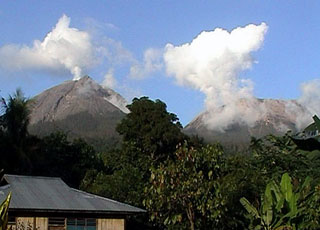Report on Lewotobi (Indonesia) — 31 January-6 February 2024
Smithsonian Institution / US Geological Survey
Weekly Volcanic Activity Report, 31 January-6 February 2024
Managing Editor: Sally Sennert.
Please cite this report as:
Global Volcanism Program, 2024. Report on Lewotobi (Indonesia) (Sennert, S, ed.). Weekly Volcanic Activity Report, 31 January-6 February 2024. Smithsonian Institution and US Geological Survey.
Lewotobi
Indonesia
8.542°S, 122.775°E; summit elev. 1703 m
All times are local (unless otherwise noted)
PVMBG reported that the eruption at Lewotobi’s Laki-laki volcano was ongoing during 31 January-6 February. Incandescence at the summit and from the lava flow on the NE flank was visible in webcam images during the week. On 31 January dense white-and-gray ash plumes rose as high as 700 m above the summit and drifted N and NE. At 0825 on 2 February a white-and-gray ash plume rose 700 m and drifted N and a pyroclastic flow descended the N flank as far as 500 m. An eruptive event was recorded at 1248 but it was not observed. At 1429 a dense white-and-gray ash plume rose as high as 1.5 km and drifted N. White steam-and-gas plumes were visible on the other days rising to 500 m above the summit and drifting N, NE, and S; no emissions were observed on 4 February. The Alert Level remained at 3 (the second highest level on a scale of 1-4) and the public was warned to stay outside of the exclusion zone, defined as a 4-km radius around Laki-laki crater, 5 km to the NNE, and 6 km on the NE flanks.
Geological Summary. The Lewotobi edifice in eastern Flores Island is composed of the two adjacent Lewotobi Laki-laki and Lewotobi Perempuan stratovolcanoes (the "husband and wife"). Their summits are less than 2 km apart along a NW-SE line. The conical Laki-laki to the NW has been frequently active during the 19th and 20th centuries, while the taller and broader Perempuan has had observed eruptions in 1921 and 1935. Small lava domes have grown during the 20th century in both of the summit craters, which are open to the north. A prominent cone, Iliwokar, occurs on the E flank of Perampuan.
Sources: Pusat Vulkanologi dan Mitigasi Bencana Geologi (PVMBG, also known as CVGHM), Antara News, Antara News

